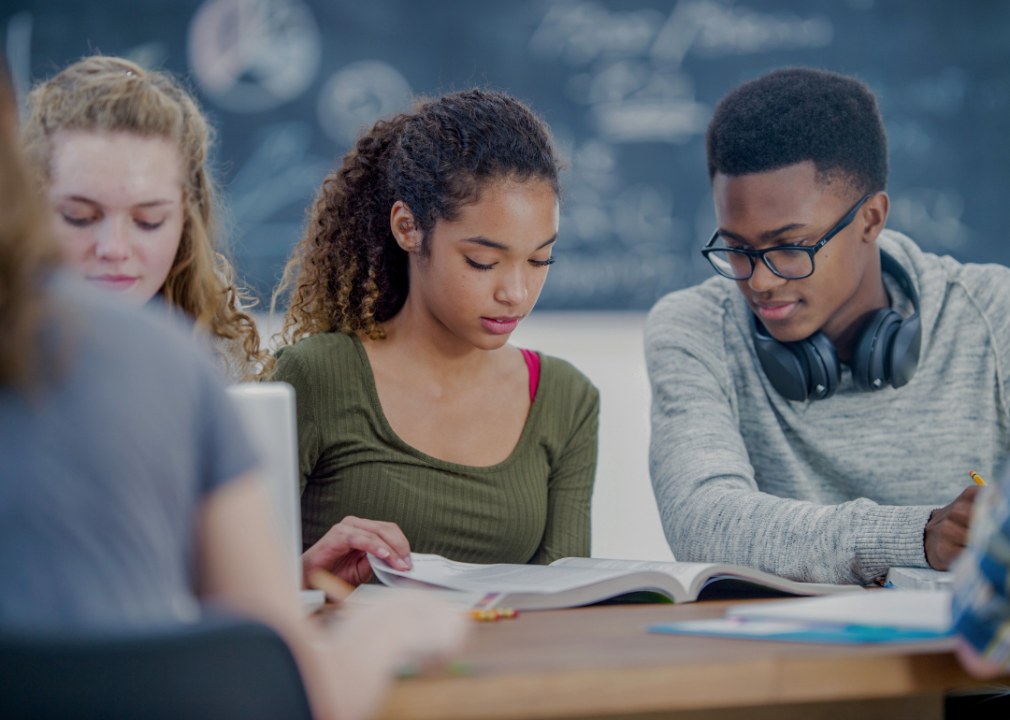Will this be the year K-12 students recover from the pandemic's effect on learning?

Canva
Will this be the year K-12 students recover from the pandemic’s effect on learning?
A group of diverse students sitting together in a classroom looking at the books in fornt of them. In the background, a chalkboard with various mathematical equations or diagrams visible.
As a new school year begins, students are still struggling to achieve grade-level proficiency in reading and math, compounding the learning loss during school closures at the height of the COVID-19 pandemic.
HeyTutor analyzed news reports and academic research to see how learning loss during the coronavirus pandemic might impact students during the 2024-2025 school year.
A 2024 Annie E. Casey Foundation report revealed that many students in the United States are still performing far below their grade level. Only 1 in 4 eighth graders were proficient in math in 2021, down from about 1 in 3 students in 2019. The report also revealed that fewer than 1 in 3 fourth graders were proficient in reading, 32% down from 34% in 2019.
The achievement gap before and after the pandemic widened during the 2023-2024 school year in nearly all grades, increasing by 36% in reading and 18% in math, according to a 2024 NWEA report.
Absenteeism has also had a profound effect on student learning. Despite recent improvements, the rates of absent students remain high compared to prepandemic levels. Chronic absenteeism nearly doubled prepandemic rates, showing that as many as 14.7 million (or a third of the student population) missed 15 days of school or more during the 2021-2022 academic year. This also meant that 2 out of 3 students attended schools with high chronic absence rates.
Research shows that middle and high school students impacted by the coronavirus lockdowns still struggle. The extent of their learning loss is reflected in standardized test scores. The Program for International Student Assessment, an international test for 15-year-olds, found that between 2018 and 2022, students’ scores worldwide dropped significantly, with math scores decreasing by a record 15 points and reading scores sliding by 10 points, twice the previous record.
In the United States, where ACT scores have declined since 2017, the “COVID cohort” class of 2023 had the lowest average score of 19.5 out of a maximum score of 36, according to data from the National Center for Education Statistics. When disaggregated by race, American Indian and Alaskan Native and Black students scored 16, Pacific Islanders scored 16.3, and Hispanic students scored 17.4.
![]()

Canva
Amid COVID-19 pandemic-related learning loss, a widening achievement gap
A young girl lying on her stomach. She is resting her head on one hand while looking down at something in front of her.
The far-reaching impact of COVID-era learning loss was particularly pronounced among low-income and Black, Hispanic, and Native students, exacerbating existing disparities. Barriers to learning, a growing digital divide, and a lack of mental health support in schools all contributed to a widening achievement gap between students who have access to resources and those who do not.
Because of COVID-19’s disproportionate impact on Black, Hispanic, and Native adults, the effects on children were amplified. Adults experienced higher death rates, increased unemployment, and elevated levels of depression and anxiety compared to their white counterparts. Students attempting to learn remotely faced additional setbacks in families burdened by the added stress of a parent losing a job or the trauma of a sick loved one. Moreover, as many as 4 in 10 students experienced at least one adverse childhood experience during the pandemic, such as economic hardship or broken families due to separation, divorce, or incarceration.
“The message that the pandemic sent was that you’re not going to be successful teaching math and reading and science and social studies if kids haven’t eaten, they haven’t slept, they’re worried about their dad’s job or their grandmother’s recent death,” Thomas Toch, director of the independent think tank FutureEd told ABC News earlier this year.
Existing disparities also fall along geographic lines. Students in rural communities are more likely to lack access to the standard technology that has become crucial for academic success. At least 13 out of every 100 rural households lack the minimum broadband connection needed to access virtual classrooms or stream educational videos. One in 6 rural households across six states— Arkansas, New Mexico, Mississippi, Alabama, West Virginia, and Louisiana—lack basic broadband access. In Tribal communities, as many as 1 in 3 households lack high-speed internet.
Poor rural school children tested lower in 2022-2023 but not as low as students in general. For instance, students from families with incomes below the federal poverty threshold score 27 points lower on the eighth-grade National Assessment of Educational Progress math assessment, but rural kids score 22 points lower.
Disparities also exist in nonacademic aspects of education. In nonrural districts, 1 in nearly 300 students have access to a psychologist or school counselor, compared to 1 in 400 rural students, according to the 2023 Why Rural Matters report.
As Dr. Karyn Lewis and Dr. Megan Kuhfel concluded in the NWEA report: “Our most pressing concerns should lie with students who were already teetering on the edge within our education system when COVID-19 hit—those grappling with systemic racism, poverty, and restricted access to opportunity and resources. We already owe these students a great educational debt, and it is a debt we carry with compounding interest.”

Canva
As coronavirus relief funds end, educators look for ways to boost student learning
A group of five young children gathered around a globe in a classroom or library setting. The children, who are of different ethnic backgrounds, are all focused on the globe.
As of the last academic year, the average student will need nearly five additional months of schooling to catch up in reading and about four additional months to catch up in math. What’s more, federal Elementary and Secondary School Emergency Relief funds that served as a crucial stopgap measure for school recovery expire in September. As ESSER funds dry up, schools nationwide will be at greater risk of teacher layoffs, the loss of important programming and after-school programs, and even school closures. In low-income districts, these risks are amplified.
Concerned that the pandemic recovery interventions are considered “temporary crisis-mitigation tactics” rather than essential educational help, NWEA analysts recommend that high-dosage tutoring and summer programming become permanent areas of the educational agenda.
A new school year, complete with fresh school supplies and the buzz of new friendships, is often a hopeful time—but some students will continue to face an uphill academic battle. Fighting absenteeism, targeted tutoring, mental health support, extracurricular activities, and summer programs can all improve outcomes, but they require ongoing funding. To bridge persistent gaps stemming from systemic racism and poverty, access to school breakfasts and lunches and a reliable internet connection are also essential basics that facilitate learning, according to the Casey Foundation.
Since the worst of COVID-19-related educational disparities have not been mitigated, experts at the University of Southern California believe schools and policymakers should see the pandemic as an opportunity to reimagine and restructure the learning experience. Although the pandemic is still affecting our children, sustainable solutions could help bridge the achievement gap.
Story editing by Alizah Salario. Additional editing by Kelly Glass. Copy editing by Sofía Jarrín. Photo selection by Ania Antecka.
This story originally appeared on HeyTutor and was produced and
distributed in partnership with Stacker Studio.